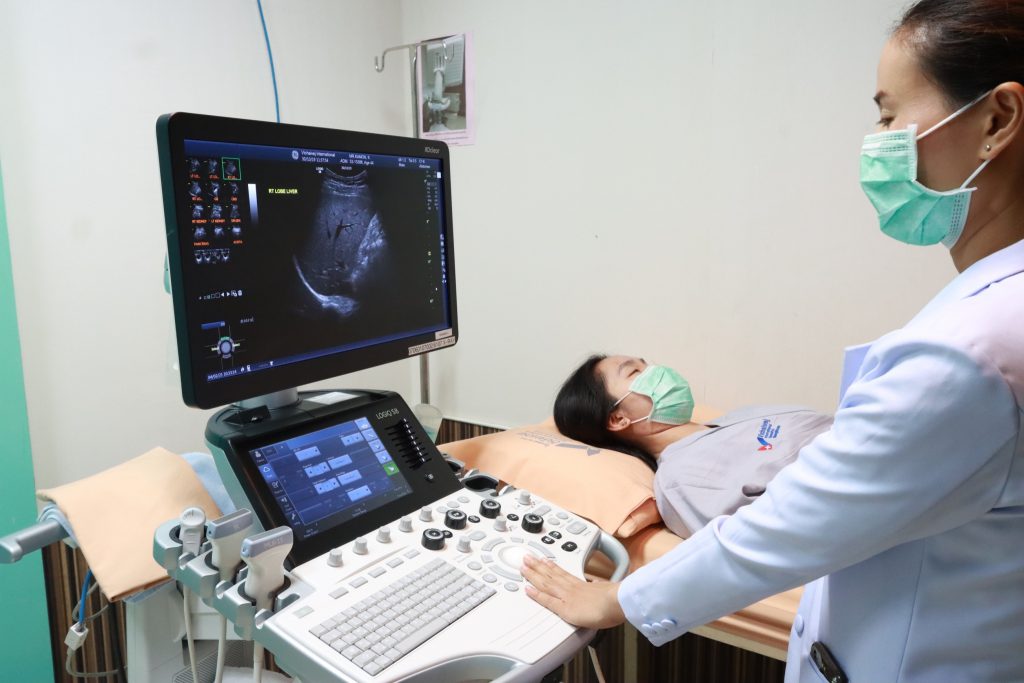- Home
- Medical Technology
- Diagnostic Ultrasound Machine

Ultrasound diagnosis utilizes high-frequency sound waves beyond what human ears can hear. This sound wave does not cause any harm from ll in the frequency and quantity used in medicine. Therefore, it has been widely used in the initial examination and general diagnosis, especially in children and fetuses since in addition to not being harmful, the patient would not feel pain in the examined area aside from just a little pressure.
Ultrasound can be employed to examine many organs, such as heart, liver, spleen, kidney, gall bladder, abdomen, and uterus, and patient preparation is quite simple.
Indication
- Detect general abnormalities, such as kidney stones, gallbladder stones, liver masses, etc.
- Confirm the detection of a lump.
- Monitor the changes of the lesions.
- Penetrate the suspected organ for diagnosis and treatment.
- Identify sex, abnormality, and size of the fetus.
- Detect abnormalities of the veins and arteries that are clogged, bulging or varicose, etc.
- Examine heartbeats, myocardial contractility, heart valves, heart muscle abnormalities, and proximal artery (by a cardiologist).
- Examine the baby’s brain from birth to 1 year old.
Limitation of Ultrasound
- Inability to examine organs that have air such as lungs, and stomach, since the air does not reflect the waves back, making it impossible to receive a signal to create a photograph.
- Inability to examine bony organs or being blocked by the bones since the bones would reflect the waves back, making it impossible to penetrate the organ.
เมื่อคุณเข้าชมเว็บไซต์ใดก็ตาม ไซต์นั้นอาจจัดเก็บหรือดึงข้อมูลจากเบราว์เซอร์ของคุณ ส่วนใหญ่แล้วอยู่ในรูปแบบของคุกกี้ ข้อมูลนี้อาจเกี่ยวกับคุณ การตั้งค่าของคุณ อุปกรณ์ของคุณ หรือเพื่อช่วยให้ไซต์ทำงานอย่างที่คุณต้องการ ซึ่งมักเป็นข้อมูลที่ไม่สามารถระบุตัวตนของคุณได้โดยตรง แต่ช่วยให้คุณใช้งานเว็บตามความต้องการส่วนบุคคลได้มากยิ่งขึ้น ท่านสามารถศึกษาข้อมูลเพิ่มเติมได้ที่ นโยบายคุกกี้ (Cookie Policy) และ นโยบายความเป็นส่วนตัว (Privacy Policy)
การใช้งานเว็บไซต์นี้เป็นการยอมรับข้อกำหนดและยินยอมให้เราจัดเก็บคุกกี้ตามนโยบายที่แจ้งในเบื้องต้น
ศูนย์การตั้งค่าความเป็นส่วนตัว
ความเป็นส่วนตัวของคุณ
เมื่อคุณเข้าชมเว็บไซต์ใดก็ตาม ไซต์นั้นอาจจัดเก็บหรือดึงข้อมูลจากเบราว์เซอร์ของคุณ ส่วนใหญ่แล้วอยู่ในรูปแบบของคุกกี้ ข้อมูลนี้อาจเกี่ยวกับคุณ การตั้งค่าของคุณ อุปกรณ์ของคุณ หรือเพื่อช่วยให้ไซต์ทำงานอย่างที่คุณต้องการ ซึ่งมักเป็นข้อมูลที่ไม่สามารถระบุตัวตนของคุณได้โดยตรง แต่ช่วยให้คุณใช้งานเว็บตามความต้องการส่วนบุคคลได้มากยิ่งขึ้น ท่านสามารถศึกษาข้อมูลเพิ่มเติมได้ที่ นโยบายคุกกี้ (Cookie Policy) และ นโยบายความเป็นส่วนตัว (Privacy Policy)
การใช้งานเว็บไซต์นี้เป็นการยอมรับข้อกำหนดและยินยอมให้เราจัดเก็บคุกกี้ตามนโยบายที่แจ้งในเบื้องต้น
คุกกี้เหล่านี้จำเป็นสำหรับการทำงานกับเว็บไซต์ และไม่สามารถปิดการใช้งานในระบบของเราได้ และโดยปกติแล้ว คุกกี้เหล่านี้จะถูกกำหนดไว้เพื่อตอบสนองต่อการดำเนินการร้องขอบริการของคุณ เช่น การตั้งค่าความเป็นส่วนตัว การเข้าสู่ระบบ หรือการกรอกแบบฟอร์ม คุณสามารถกำหนดให้เบราว์เซอร์ของคุณทำการบล็อก หรือเตือนให้คุณทราบเกี่ยวกับคุกกี้เหล่านี้ แต่นั่นอาจทำให้บางส่วนของไซต์ไม่สามารถทำงานได้
คุกกี้เหล่านี้ช่วยในการทำงานของไซต์และการปรับแต่งไซต์ให้เหมาะกับผู้ใช้ เช่น วิดีโอและการสนทนาสด คุกกี้เหล่านั้นอาจได้รับการกำหนดโดยเราหรือผู้ให้บริการจากบริษัทอื่นที่เราได้เพิ่มบริการของพวกเขาลงในหน้าเพจ หากคุณไม่อนุญาตให้คุกกี้เหล่านี้ทำงาน ฟังก์ชันบางอย่างของไซต์อาจทำงานไม่ถูกต้อง
คุกกี้เหล่านี้ช่วยเราในการนับจำนวนและที่มาของการเข้าชม เพื่อให้เราสามารถวัดและปรับปรุงประสิทธิภาพไซต์ของเราได้ นอกจากนี้ยังช่วยให้เราทราบว่าหน้าใดได้รับความนิยมมากที่สุดและน้อยที่สุด และทราบว่าผู้เยี่ยมชมเข้าดูส่วนใดบ้าง ข้อมูลทั้งหมดที่คุกกี้เหล่านี้จัดเก็บไว้จะถูกรวมไว้ด้วยกัน จึงทำให้ไม่สามารถระบุตัวตนได้ หากคุณไม่อนุญาตให้คุกกี้เหล่านี้ทำงาน เราจะไม่ทราบว่าคุณเข้าชมไซต์ของเราเมื่อใด
โรงพยาบาลวิชัยเวชหนองแขมได้มีการใช้เทคโนโลยี Google Analytics และ Facebook Pixel ซึ่งมีวัตถุประสงค์เพื่อใช้เก็บข้อมูลเชิงลึกเกี่ยวกับรูปแบบการใช้งานของคุณบนเว็บไซต์ของเรา โดยข้อมูลนี้ประกอบไปด้วย หน้าเว็บไซต์ที่คุณเข้าชม ลิงค์ที่คุณคลิก ระยะเวลาที่คุณเข้าชมแต่ละหน้า โดยเราใช้ข้อมูลนี้เพื่อวิเคราะห์รูปแบบการใช้งานของผู้ใช้ และเพื่อให้เว็บไซต์ทำงานได้อย่างถูกต้อง เราขอยืนยันว่าจะไม่ใช้ข้อมูลนี้เพื่อการตลาดหรือการโฆษณา และจะไม่เปิดเผยกับบุคคลที่สามแต่อย่างใด
คุกกี้เหล่านี้จะถูกกำหนดผ่านไซต์ของเราโดยพาร์ทเนอร์โฆษณาของเรา โดยบริษัทดังกล่าวอาจใช้คุกกี้เหล่านี้เพื่อสร้างโปรไฟล์เกี่ยวกับความสนใจของคุณ และแสดงโฆษณาที่คุณสนใจบนไซต์อื่นๆ คุกกี้เหล่านี้ทำงานโดยการระบุแต่ละเบราว์เซอร์และอุปกรณ์ของคุณ หากคุณไม่อนุญาตให้คุกกี้เหล่านี้ทำงาน คุณจะไม่เห็นโฆษณาที่คุณเป็นเป้าหมายบนเว็บไซต์ต่างๆ
คุกกี้เหล่านี้ได้รับการกำหนดโดยบริการโซเชียลมีเดียที่เราได้เพิ่มบนไซต์ เพื่อช่วยให้คุณสามารถแบ่งปันเนื้อหากับเพื่อนๆ และเครือข่ายของคุณได้ คุกกี้เหล่านี้สามารถติดตามเบราว์เซอร์ของคุณเมื่อเข้าชมไซต์อื่นๆ และสร้างโปรไฟล์เกี่ยวกับความสนใจของคุณได้ ซึ่งจะส่งผลต่อเนื้อหาและข้อความที่คุณเห็นบนเว็บไซต์อื่นๆ ที่คุณเข้าชม หากคุณไม่อนุญาตให้คุกกี้เหล่านี้ทำงาน คุณจะไม่สามารถใช้หรือดูเครื่องมือการแบ่งปันเหล่านี้ได้

